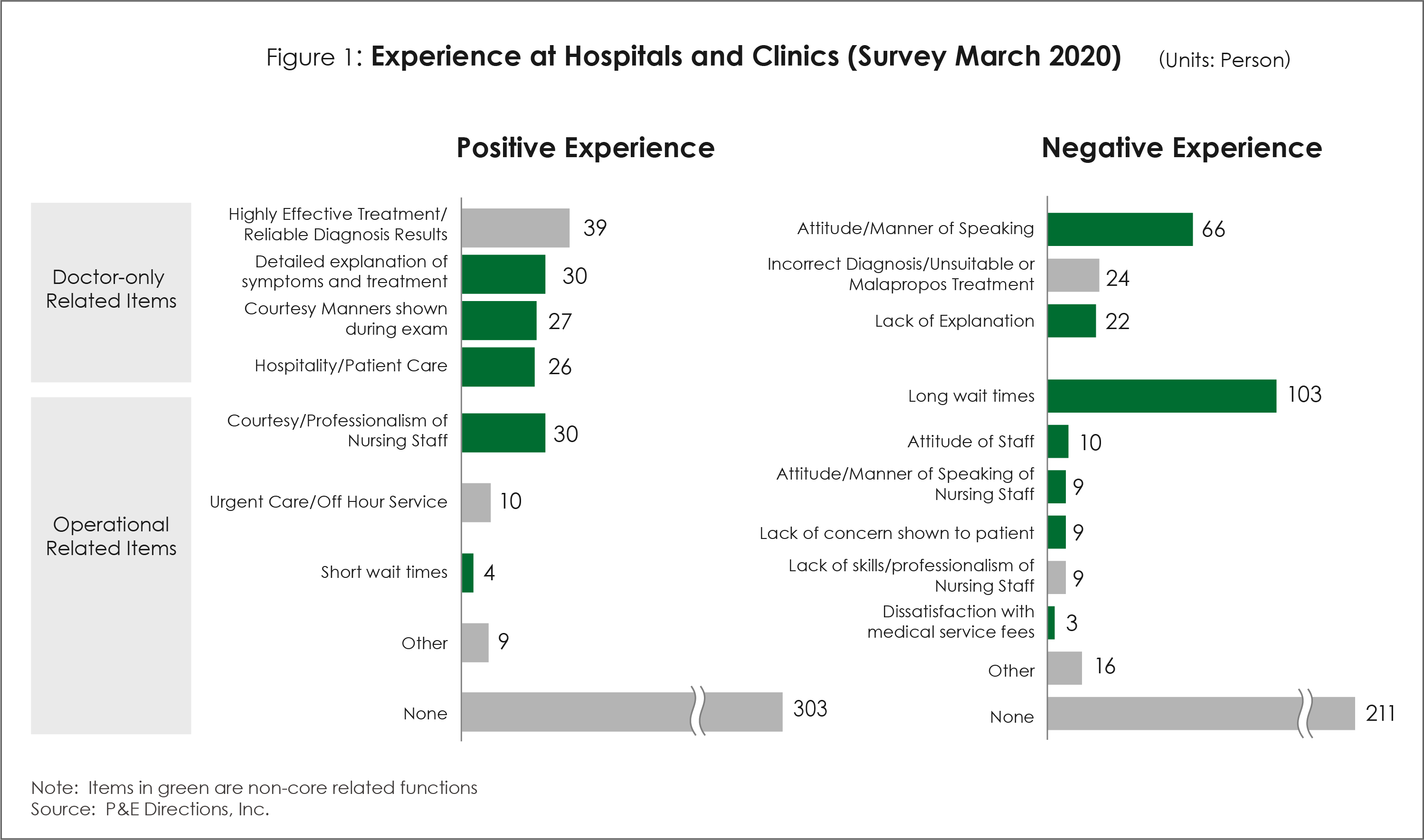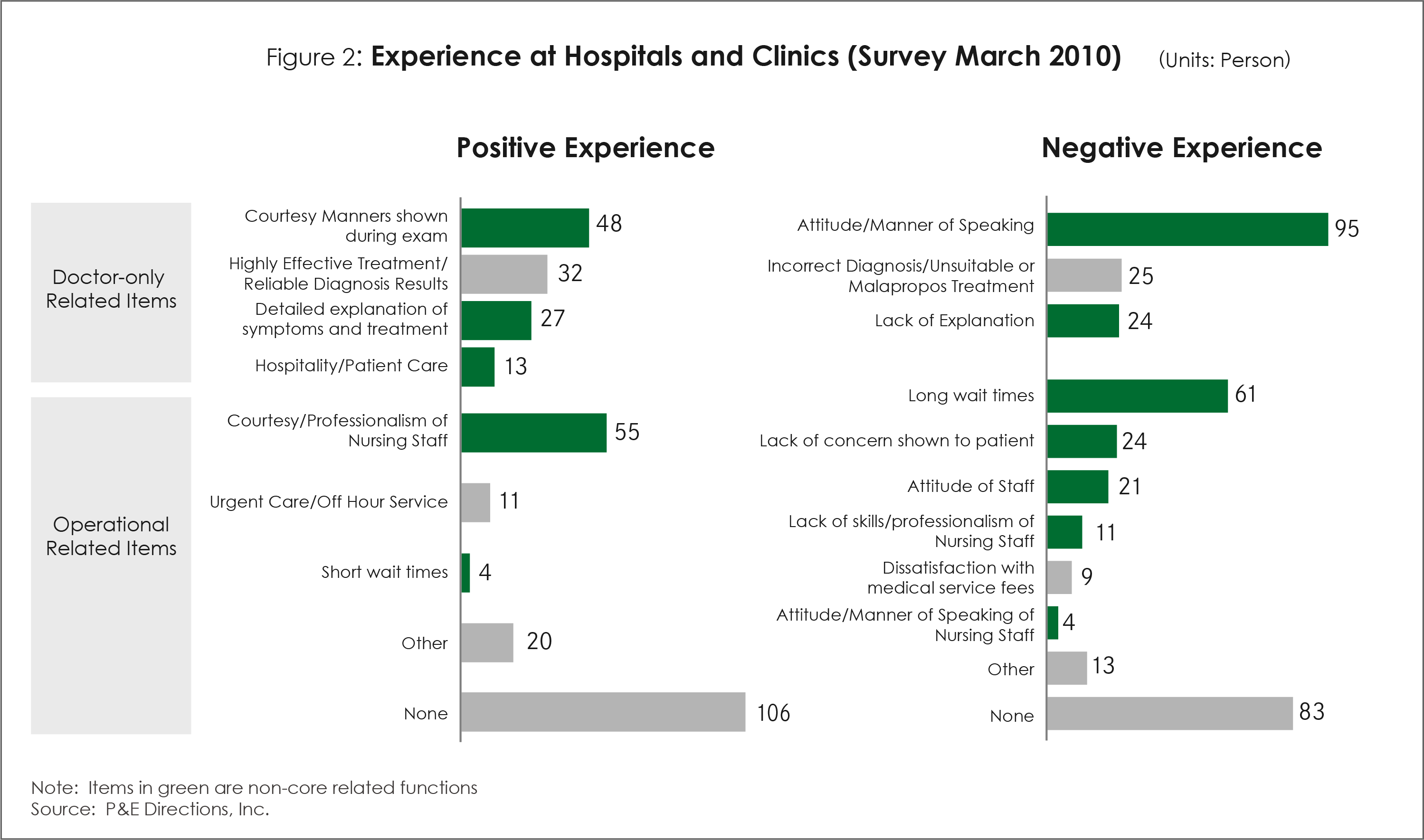- 2020.06.10
- RESEARCH/CONTENTS
Survey Results Regarding Patience Experience of Medical Services

In early March 2020, P&E Directions conducted a survey regarding patient experience of medical services provided at hospitals and clinics.
Figure 1 shows the results for the survey conducted in March 2020 on 500 people over the age of 50. Figure 2 displays the results of the exact same survey conducted in March 2010. Items were categorized by occupation (Doctors/Nurses・Staff) and content, and results were tallied by “Positive Experience” and “Negative Experience”.
Looking at Figure 1, with regards to hospitals and clinics the most positive results were in the area of “Highly Effective Treatment/Reliable Diagnosis Results”, with 39 responses, followed by “Detailed Explanation of Symptoms and Course of Treatment, with 30 positive responses. Further, “Politeness of Doctor, Kindness felt during medical examination”, “Compassionate manner of speaking by Doctor/Kindness shown/Ability to keep pace with the patient”, “Professionalism and Courtesy shown by Nursing Staff” collectively received 83 positive responses. Looking at the “Negative Experience” responses, with respect to hospital operations, 103 people responded negatively to “Length of Waiting Time”, the highest negative response on the survey. In fact, 1 in 5 people responded negatively to this point. This number correlates directly to the experience with doctors, who are a fundamental element of hospital operations, and clearly demonstrates a lack of satisfaction in the medical service area. Further, with respect to doctor-related experiences, a large number of people (66 responses) responded negatively to the attitude of the doctor and the doctor’s choice of words when speaking. There was also a large increase in negative responses regarding “Incorrect Diagnosis/Unsuitable or Malapropos Treatment”, with a total of 24 responding negatively. While it is important to show both positive and negative results for core medical treatment functions, it has become apparent that “secondary” medical treatment functions, such as the patient experience including remedial treatment and the patient/medical staff interaction, are also of equal importance. This appears to be the case, even as compared to the survey data from 10 years ago (see Figure 2.)
In listening to the patients’ comments directly, for example, there was a 57-year-old female who underwent a kidney transplant. Post-operation, she went to the hospital for a routine checkup, and complained of being “tired” when she was in fact suffering from slight depression. Her doctor immediately told her “Regardless of when your next appointment is, if you feel the need to come see me, come at any time.”, which made the patient feel supported emotionally. A 62-year-old male patient commented “My post-op follow-up was excellent. The doctor called me the day after I left the hospital and ask me how I was feeling, which made me feel really happy.” On the other hand, taking a look at the negative feedback of hospitals and clinics, we see a case of a 72-year-old man who reported being spoken to negligently by a doctor when he expressed hesitation in taking a strong anti-cancer medication that the doctor was recommending citing concerns regarding the side effects. In another case, a 54-year-old woman commented that she visited a hospital during the night. The physician in charge simply asked her what her symptoms were without looking at her or taking his eyes off of his computer.
In thinking about the reason why there are completely opposite viewpoints in the same medical service area, one can say it is possibly based on the different points of view on the medical service provider side. For those taking action from the patient’s point of view, we can see a connection in those that made positive comments regarding their experience. However, incidents where the approach was strictly from the medical service provider’s point of view resulted in negative comments. The latter is something called “supplier logic”, and is generally often seen in groups with a high level of expertise. Since medical service requires a high level of expertise, one can assume that this group is more likely to have supplier logic. This survey, therefore, demonstrates that many patients desire a customer-centric type of service.
In Japan, currently faced with the COVID-19 pandemic and the approaching crisis of the increasing elderly population in 2025, better ways to provide medical services, such as online medical diagnosis and regional comprehensive care, are being explored. Given the severity of the current times, it may be necessary for medical institutions and health care companies to re-evaluate areas such as the value and convenience of medical services, costs, including those related to patient wait times, and the best way to communicate with patients, all from the patient’s (customer’s) point of view.
Author: Shuhei Yamada (Manager)












